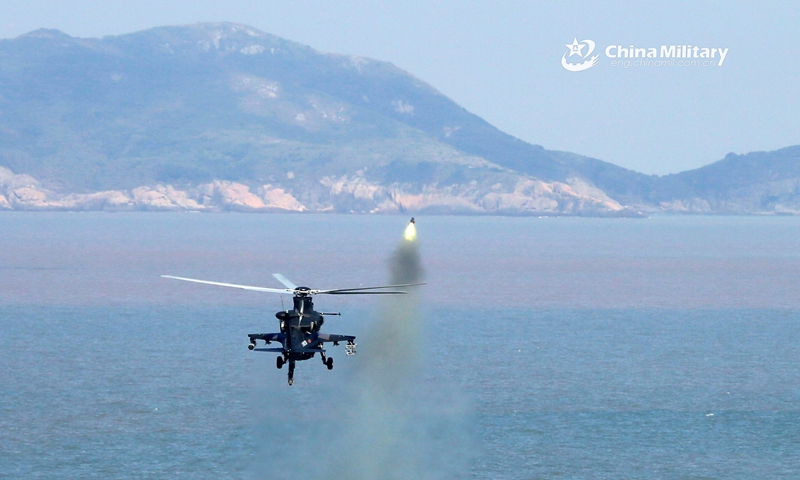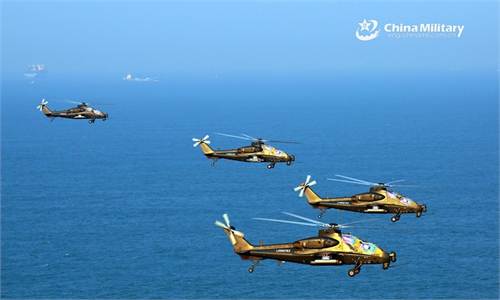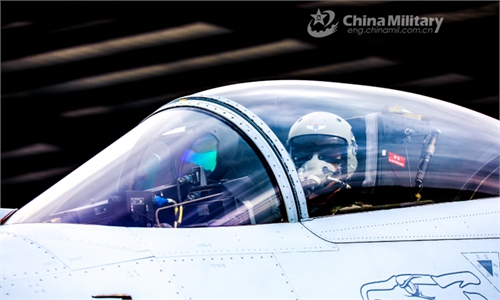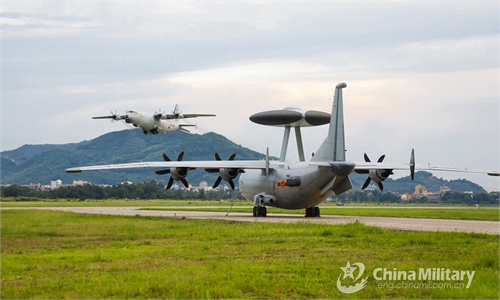PLA holds amphibious landing drills to ‘show firm will against Taiwan secessionists’
Unmanned weapons shine in mainland exercises, boost efficiency in island seizure operations

An attack helicopter attached to an army aviation brigade under the PLA 72nd Group Army fires rocket at a simulated target on the island during a fire strike training exercise in late September, 2020. (eng.chinamil.com.cn/Photo by Zhang Huanpeng)
The Chinese People's Liberation Army (PLA) recently conducted large-scale joint amphibious landing drills off the Chinese mainland's southeastern coast amid increasingly rampant Taiwan secessionist moves, including hundreds of espionage attempts on the Chinese mainland and collusion with the US. Chinese mainland analysts said on Sunday that the PLA drills again demonstrate the mainland's strong capability and firm will against Taiwan secessionists and push for reunification, following PLA aerial and naval exercises and patrols in the Taiwan Straits that have continued for nearly a month.
The exercises featured concentrated deployments of unmanned aerial, surface and ground vehicles, which will significantly boost the PLA's efficiency in seizing the control of an island, experts said.
Cross-service multidimensional joint amphibious landing exercises recently started in waters off the coast of East China's Fujian and South China's Guangdong provinces, in which the combined amphibious forces affiliated with the PLA 73rd Group Army integrated with newly established forces including army aviation, special operation and electronic countermeasures units and comprehensively tested their combat capabilities in realistic war scenarios, China Central Television (CCTV), the state broadcaster, reported on Sunday.
A large number of amphibious landing ships are seen in the report footage transporting amphibious armored vehicles, tanks, artillery and troops to the target island.
Before the assault, scout units first conducted reconnaissance on the enemy using aerial drones, guiding strikes on hostile artillery and missile positions. Unmanned ships deployed forward to destroy sea mines and obstacles, opening a safe sea lane, with multiple waves of attack helicopters launching low-altitude aerial assaults in formation on remaining hostile positions, providing cover for the landing forces.
After that, amphibious armored assault groups soon made it to dry land, and tanks and infantry fighting vehicles wiped out remaining hostile targets and captured their positions. Multiple types of unmanned ground vehicles were seen in the CCTV report footage, including some equipped with guns and some carrying ammunition for foot soldiers.
Song Zhongping, a Chinese mainland military expert and TV commentator, told the Global Times on Sunday that the cross-sea amphibious landing is the most important strategy to prepare for a military conflict against Taiwan, which may be the only way to resolve the Taiwan question if it comes to that point.
As amphibious landing is an extremely challenging operation to militaries all over the world, the PLA must enhance related capabilities so it will become capable of taking over the island of Taiwan with the fastest speed, Song said.
The PLA's amphibious landing exercises come at a time when Taiwan secessionists have been increasingly frequently making statements and moves to try to separate Taiwan from China, and the exercises showed the Chinese mainland's strong capability and firm will against Taiwan secessionists and push for reunification.
Taiwan regional leader Tsai Ing-wen, in an address on Saturday, continued the confrontational mindset and hostile mentality, boasted rhetoric about seeking "independence," advocated collusion with foreign forces and confused the minds of people in the island, Zhu Fenglian, spokesperson for the Taiwan Affairs Office of China's State Council, said on Saturday.
Taiwan secessionist forces have made more and more attempts to conduct espionage on the Chinese mainland in recent years in order to disrupt cross-Straits exchanges and resist the reunification of China, and recently, hundreds of Taiwan espionage cases have been cracked down by the mainland's state security agency in an operation codenamed "Thunder-2020."
The US is also playing the Taiwan card, as it sent a warship to the waters off China's Xisha Islands in the South China Sea on Friday without China's approval, a move Taiwan media interpreted as pressuring the PLA over its drills in the Taiwan Straits. The US is also increasingly selling weapons and sending senior officials to the island.
The Chinese Defense Ministry and the PLA Eastern Theater Command announced in mid-September that the PLA was holding joint maritime and aerial exercises and combat-readiness patrols in the Taiwan Straits. No amphibious landing exercises featuring ground forces were announced at that time.
Xu Guangyu, a senior adviser to the China Arms Control and Disarmament Association, told the Global Times on Sunday that while the latest amphibious landing drills are tactical exercises, they serve as a concrete move of strategic deterrence.
Many Taiwan secessionists do not understand the true capability of the PLA in terms of cross-sea combat, and they think the mainland's reunification-by-force is only a verbal threat, Xu said.
The drills are of significant meaning in telling Taiwan secessionists that the PLA is making concrete steps in preparing for such an operation, and also in telling the US that the PLA has the capability and determination to carry out a reunification-by-force operation if peaceful reunification becomes beyond reach, Xu said.
Chinese mainland military observers also noted the concentrated deployment of unmanned equipment in the drills, including aerial reconnaissance drones, unmanned obstacle-breaking ships and unmanned ground vehicles for both attack and transport purposes.
The deployment of drones in the sky, on the ground and in the sea can significantly boost the efficiency of island seizure combat by lowering the casualty rate of the attacking forces, providing intelligence support and extra firepower, and replace humans in physical work, analysts said, noting that if a war breaks out, many Taiwan soldiers will have been killed before even seeing a real PLA soldier.




